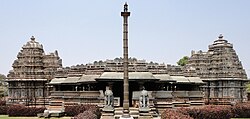Belavadi
| Belavadi | ||
|---|---|---|
|
|
||
| State : |
|
|
| State : | Karnataka | |
| District : | Chikmagalur | |
| Location : | 13 ° 17 ′ N , 76 ° 0 ′ E | |
| Height : | 843 m | |
| Residents : | 2,286 (2011) | |
| Belavadi - Vira Narayana Temple | ||
Belavadi or Belawadi is a village with approx. 2,500 inhabitants in the Chikmagalur district in the southwest Indian state of Karnataka . The place is known for its Hoysala Temple, which was built around 1200 .
location
Belavadi lies on the Dekkan Plateau at an altitude of approx. 845 m above sea level. d. M. almost 30 km (driving distance) east of the district capital Chikmagalur or a good 10 km north of Halebid . Because of the altitude, the climate is rather moderate by Indian standards; Rain falls mainly during the monsoon months June to October.
population
The majority of the Kannada- speaking population consists almost without exception of Hindus ; Muslims and other religions are numerically small minorities. The male and female proportions of the population are roughly the same.
economy
The inhabitants of Belavadi live largely as farmers - while in earlier times they were farmed almost exclusively for self-sufficiency, with the improvement in transport options, other sales markets have also been added. The fields in the area mainly grow wheat , lentils and vegetables. Even coconut trees play an important role in the economy of the region.
history
In the Middle Ages, Belavadi was an important place in the Hoysala Empire. In the 15th and in the first half of the 16th century the area was part of the Vijayanagar -rich whose power, however, with the lost battle of talikota (1565) against the Deccan sultanates went down, which in turn after 1685 from Great Mughals , Aurangzeb conquered. A few years later (1690) the area came under the control of the princely state of Mysore , whose rule, however, in the second half of the 18th century by Hyder Ali (r. 1761–1782) and his son Tipu Sultan (r. 1782–1799) was interrupted. After that, the British played the dominant military and economic role in South India.
Attractions
- The Vira Narayana Temple, built around 1200 and mostly made of soapstone , is a foundation of the Hoysala ruler Vira Ballala II (r. 1173–1220); it is consecrated to the Hindu god Vishnu and has - similar to the Chennakeshava temple in Somanathapura - a clover-leaf-shaped floor plan ( trikuta ) with three cellae ( garbhagrihas ) with shikhara towers on top with umbrella domes and kalasha vases. In the cellae are the figures of Viranarayana , Venugopala and Yoganarasimha - all three are avatars or aspects of Vishnu. While the western part of the temple was designed in simple older style forms, the outer walls of the two side cellas are clearly structured and decorated with figures. Between the cellae there are several interconnecting vestibules ( mandapas ) with turned columns and small cantilever domes with hanging keystones . The statue of the seated Venugopala in the cella is around 2.50 m tall and is one of the masterpieces of Indian sculpture.
Entrance to the cella with Gajalakshmi motif
Cantilever dome with hanger
literature
- Gerard Foekema: Hoysala Architecture: Medieval Temples of Southern Karnataka built during Hoysala Rule. Books & Books, New Delhi 1994, ISBN 978-81-8501-641-2 .
- Gerard Foekema: Complete Guide to Hoysala Temples. Abhinav Publ., New Delhi 1996, ISBN 81-7017-345-0 .
- S. Settar: The Hoysala Temples. Kala Yatra Publ., Bangalore 1992, ISBN 978-81-9001-721-3 .
Web links
- Belavadi, temple - photos + information (Wikipedia, English)
- Belavadi, Temple - Information ( Memento from March 9, 2007 in the Internet Archive )







